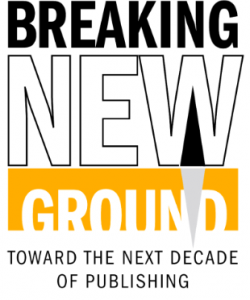 This article was kindly submitted by Laura Brady and Daniella Levy-Pinto who are presenting this Business Case for Accessibility at The Toronto Book Summit 2019 on June 18. Laura is Director of Cross-Media at House of Anansi Press and runs the highly respected and popular ebookcraft conference in Canada. Daniella is the Coordinator for Accessibility Testing with the National Network for Equitable Library Service (NNELS). As a totally blind reader, Daniella has considerable experience with accessible formats and accessible reading.
This article was kindly submitted by Laura Brady and Daniella Levy-Pinto who are presenting this Business Case for Accessibility at The Toronto Book Summit 2019 on June 18. Laura is Director of Cross-Media at House of Anansi Press and runs the highly respected and popular ebookcraft conference in Canada. Daniella is the Coordinator for Accessibility Testing with the National Network for Equitable Library Service (NNELS). As a totally blind reader, Daniella has considerable experience with accessible formats and accessible reading.
Publishing people don’t want to hear much about ebooks at the moment. Print is surging, ebooks are static—all the stats say so. Do we really have to talk about ebooks anymore? People love the smell of print, it’s been proven. There are even candles that smell like print books. Consumer nostalgia for print is real, so why do we need to keep discussing ebooks?
Despite my ride-or-die ebook reputation, I am a traditionally-trained typesetter and a hard-core print fetishist, believe it or not. There is nothing sexier than good typography, nice paper, or a well-designed cover that you can touch. My house is overrun with books, to be honest. (I am biding time until the kids move out and I can convert their rooms to libraries.) But I labour in cross-media and think a heck of a lot about inclusion, diversity, and the reading experience.
What’s not always obvious in the conversations about the smell of print is that there is a healthy slice of the reading population for whom paper books are duds. The smell has nothing on the fact that they can’t see the words or navigate the pages.
A doctrinaire approach to print books is, by its nature, exclusive and self-involved.
I know what you’re thinking. “You want me to put more time and energy into ebooks? How on earth can I justify that?” We want to arm you with the facts and figures that you need to go back to your publishing houses to make an argument for doing better when it comes to digital publishing. A little known fact is this: ebooks are not automatically accessible
Learning how to design and publish inclusive content as a standard part of your workflow makes great business sense. Being aware of how content and design may create barriers to reading also helps us generate new ideas and designs. It highlights opportunities to create solutions with utility and elegance that will create better books for everyone.
Making Better Ebooks
Electronic publications have great potential for users with print disabilities to gain access to information that might otherwise be inaccessible to them. Print disabilities, according to Canada’s Copyright Act, includes visual, mobility, or comprehension impairments. The word accessibility means the “ability” to “access.” In this instance, we are talking about access to information but, as with all situations, accessibility refers to how something is designed to be used, reviewed, read, or otherwise accessed by someone with a disability or impairment of some kind.
The advent of ebooks meant that for the first time in history, blind and other print-disabled users were able to gain access to the same books and publications at the same time as the rest of the population, at the same price. Readers with print disabilities access ebooks on computers or mobile devices using various assistive technologies, including screen readers, refreshable Braille displays, or screen magnification software. A screen reader refers to the software that runs in computers or mobile devices that reads the contents of a smartphone’s or tablet’s screen out loud, allowing users with visual disabilities to access information. They utilize a variety of gestures in mobile devices, or keyboard shortcuts on computers in order to execute functions.
Digital content is inherently more flexible than hard copy. It should be possible to use assistive technologies to read the text out loud with or without being able to see the screen. The user should be able to navigate easily and orientate themselves within the context of the content. It should be possible for users to change colours or magnify text and have it reflow to fit the page.
Of course, readers who cannot access print materials in a conventional way have different accessibility requirements: blind readers need to be able to navigate books like their fully sighted counterparts can, including moving between pages and chapter or section headings, and navigating to a particular section of interest from the table of contents; people with low vision or reading disabilities need to be able to adjust the presentation of content on a screen by, for example, enlarging the font size or changing font and background colours; and people with mobility impairments may need to be able to read and navigate digital books using voice commands or other assistive technology.
This, however, does not always happen. Depending on the aggregator, the publisher, and the format, readers with print disabilities can have very different experiences when trying to access a book. Many publishers and their suppliers are still clinging to EPUB 2, an inherently inferior product from an accessibility point of view. Accessibility also depends on the devices and software which the person with a print disability uses, and on the person’s knowledge and skill in using the devices and software. Needs also are changing with the development of new technologies and the familiarity of younger people (in particular) in working with them.
Opening up Markets

Let’s talk about consumer markets. There are two post-consumer organizations serving readers with print disabilities in Canada: the National Network for Equitable Library Service, and the Centre for Equitable Library Access, also known as NNELS and CELA. And they are busy. In 2018, NNELS acquired 23,911 books — and spent 7-20 hours remediating 300 of those with their limited in-house staff. In the fiscal year ending March 31, CELA’s users borrowed 1.18 million titles, 265k of which were digital versions (DAISY talking books, e-braille, etc.) These are staggering numbers for a market the size of Canada.
NNELS is both a digital public library of downloadable books and an advocate for an accessible and equitable reading ecosystem for Canadians with print disabilities. NNELS supports principles of openness, inclusion, and choice. NNELS develops and maintains a digital repository of accessible titles for Canadians with print disabilities, available through Canadian public libraries, works to advance the agenda of accessible publishing, and builds capacity by providing employment opportunities for people with print disabilities.
Anyone with a print disability can request any title through one of those organizations, thanks to the copyright exemptions that come from Bill C-11, also known as the Copyright Act. They will buy the ebook or print book and then do the incredibly laborious work of re-formatting it for its next reader —stripping junk HTML, OCR scanning, adding alt text, etc. That’s their mandate but they are actively trying to get out of that business so they can focus on being librarians. They aren’t going to just be librarians anytime soon, I’m afraid. There are a lot of slap dash ebooks in the marketplace that are going to keep the remediation work going for some time.
So what is this mythical print-disabled marketplace? Not so mythical at all. There are 37 million people in Canada; approximately 1.5 million of those meet strict criteria for being labelled as having a print disability. That number does not account for an ageing population. According to the National Coalition for Vision Health: Vision Loss in Canada, one in nine Canadians will have irreversible vision loss by 65. That figure ramps up to one in four by the age of 75. As twenty-five percent of the population will be aged 65 or over by 2030, that is a substantial chunk of readers.
So that covers vision issues, but the term print disability is broad. According to the International Dyslexia Association, between 15-20% of the population has some form of language-based learning disability. A chunk of the population has a physical issue that prevents them from holding and manipulating a book. And, I would add, this doesn’t account for situational disabilities. Listening to an audiobook while driving, or having voice aids read text aloud so the reader can be hands-free are good examples of that. A breastfeeding mother needs her hands for other things, for example. Someone who has a broken arm may have trouble navigating an ereader or website.
There is a healthy market in readers with print disabilities. And there are some preliminary statistics that point to that group of readers being more voracious than the average. The Italian accessibility organization, Fondazione LIA, points out that where texts are accessible to them, readers with print disabilities consume more than three times the number of books than the non-print-disabled population.
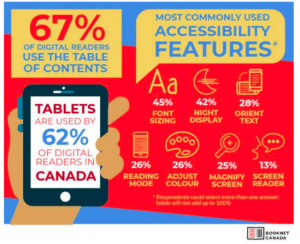
According to Booknet Canada’s 2018 How Do Readers Use Ebooks survey, approximately half of all digital readers use accessibility features of some kind. Font sizing, night mode, text orientation, reading mode, colour modifications, and screen magnification.
SenseAbility.ca states that the buying power of the Canadian disability community is $55.4 billion annually. The value of the global population of people with disabilities and their friends and family is 3.6 billion. This is a very large, untapped market. In the UK, this enormous spending power has a nickname: the purple pound.
And beyond the disability market, 87% of Canadian consumers say that they value inclusion, and 92% of consumers are more likely to support a business that is both physically and digitally accessible.
Go out there and court those readers! The consumer market is there and eager to be served.
Opening Up Government Funding Opportunities
You may have heard about the latest round of funding in the federal budget. In March of this year, the Liberal government announced 22.8 million over five years to support independent Canadian publishers to publish more accessibly. This funding is likely going to be geared towards setting publishers up to do better when it comes to ebooks. The Department of Canadian Heritage is going to administer the monies and will start “rewarding” publishers who meet standards fairly quickly, starting next year at the latest and possibly as soon as this Fall. It’s coming, people! They have two streams of funding through the Canada Book Fund: support for organizations, and support for publishers.
There are other ways to tap into government support of accessible publishing as well. Did you know that if you write “Literature for the Blind” in the upper right hand corner of a package, Canada Post will deliver it free of charge? (Please don’t abuse this knowledge.) Employment and Social Development Canada (ESDC) has a number of instruments by which they support accessible publishing in this country. This agency supports NNELS and CELA/CNIB in significant ways—project support, and ongoing funding. In January of this year, they supported the organization and staging of an Accessible Publishing Summit, which brought together various stakeholders in our industries—libraries, publishers, alternate format producers, and accessibility advocates. The work of that summit is still reverberating.
At least three provinces offer funding support in the form of tax credits to publishers. At present none of them explicitly reward born accessible content, but it’s not hard to imagine that something of this sort would be part of future programs. For example, Manitoba offers a bonus equal to 15% of printing costs back to the publisher if a book is printed on paper with a minimum of 30% recycled content. One could easily see tax credits extending to publishers who put more attention and detail into their digital publishing program. Get your house ready!
Legal Requirements
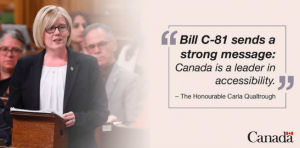
Investing in accessibility will help mitigate legal risks and ensure that you will avoid litigation—avoiding costs and the brand damage associated with legal proceedings.
The Government of Canada and several provinces are currently working towards making Canada a more inclusive, barrier-free country. This is a very brief summary of the most relevant laws:
AODA and Other Provincial Legislation
In 2005, the Accessibility for Ontarians with Disabilities Act (AODA) was passed for the purpose of “developing implementing and enforcing accessibility standards in order to achieve accessibility for Ontarians with disabilities with respect to goods, services, facilities, accommodation, employment, buildings, structures and premises on or before January 1, 2025″ (AODA, 2005). The act creates the legal framework for developing and enforcing regulations regarding accessibility.
When it comes to ebooks, the AODA’s Information and Communication Standard is what lays out accessibility requirements. It mandates public sector organizations and large organizations to make their internet websites and web content conform with the World Wide Web Consortium Web Content Accessibility Guidelines (WCAG) initially at Level A and increasing to Level AA. (O. Reg. 191/11, s. 14 (2).) As EPUB files are HTML-based, WCAG standards are therefore applicable.
Other provinces also have disability legislation as well and we recommend this website for an overview https://siteimprove.com/en-ca/blog/a-complete-overview-of-canada-s-accessibility-laws/
In brief:
Accessibility for Manitobans Act (AMA)—became law in 2013
Nova Scotia Accessibility Act—became law in 2017
British Columbia has proposed an Accessibility Act (Bill M 219), it had its first reading in the Legislature in May 2018
Bill C-81
An Act to ensure a barrier-free Canada. The Accessible Canada Act was introduced in the House of Commons in June 2018, and on May 29, 2019, it was passed unanimously in the House of Commons. The Bill now awaits Royal Assent. One of the purposes of the bill is to prevent accessibility barriers in information and communication technologies, including digital content and the technologies used to access it. Requirements of this bill, including web accessibility, will likely follow WCAG. Organizations under federal jurisdiction will be required to comply, or face a fine of up to $250,000.
It aims to set the base for the full and equal participation of all persons, especially persons with disabilities, in society. This is to be achieved by the identification, removal and prevention of barriers.
The Marrakesh Treaty
The Marrakesh Treaty is an international treaty administered by the World Intellectual Property Organization (WIPO) that was adopted in Marrakesh, Morocco, in June 2013; Canada joined in 2016. It aims to facilitate access to published works for persons with print disabilities by providing the material in formats that they can easily use. The Treaty establishes international norms that require countries to provide exceptions in their national laws to facilitate the availability of works in accessible formats for persons who are print-disabled.
In Canada, government policy on copyright exceptions for people with perceptual disabilities already aligns with the objective of the Treaty. Before Canada could accede to the Marrakesh Treaty, the government had to amend the Copyright Act to bring the exceptions in the Act for people with print disabilities in line with the obligations of the Treaty. Amendments made to the Act include the following:
- Permit the making of large-print books
- Reduce the restrictions on exporting accessible materials—authors will be allowed to send accessible-format copies of their work, regardless of their nationality, facilitating the cross-border exchange of works in accessible formats with supporting organizations in other countries.
- Safeguards to protect the commercial market for materials in accessible formats. This ensures that publishers who choose to make their books available in accessible formats can sell them in the marketplace.
In the US, the number of legal actions continues to rise and courts increasingly decide in favour of equal access often citing the Americans with Disabilities Act (ADA).
Benefits Will Ripple Through the Supply Chain
A well-made ebook won’t be sent back from any vendor. An EPUB that meets certification standards will sail into the marketplace without a hiccup. It will function better across all reading systems and platforms because of clean HTML and semantic markup. It will just work. That ebook will bounce its way into OverDrive and Hoopla. The people at NNELS will do a happy dance whose tremors you will feel.
But over and above that, you will find that ebooks that meet standards and are maybe even certified, will get privileged positioning in the marketplace. In the higher education market in the US, ebooks that are certified will receive privileged positioning in the Vital Source catalogue. (VitalSource Bookshelf a part of the Ingram Group, and is an ebook platform that allows you to access course materials whenever and wherever you choose–laptop, desktop or mobile device. You can download texts directly or access them via your browser.) Consumers who need content for specific needs will be able to search for content that is resizable, or has image descriptions, for example. And instructors can search through the Vital Source catalogue for course material identified with the accessibility icon.

It feels like it’s just a matter of time before this becomes more common. We would love to see this ripple out in the library context, to make it easier for readers who need certain features to find the books they want to read. Given OverDrive’s dismal record on accessibility and their dominance in the library world, this feels unlikely in the short term. But the fine folks at NNELS and CELA would love to see trade publishing using accessibility metadata.
Further, the use of good accessibility metadata will mean that in some contexts, your content will be more discoverable. You can use a11y metadata to indicate if that your ebook is structured, is resizable, has alternative text on images, has ARIA semantics descriptors built as well as many other features that you may wish to highlight.
It’s worth referring back to Fondazione LIA again, the Italian accessible publishing organization. Starting in 2011 as a project carried out by the trade association of Italian publishers, their goal has been to increase access to content for people with visual impairments. It has been supported by the Italian government since the beginning. They have built a catalogue of 20 thousand accessible ebooks, with more than 400 titles added per month. They are an excellent example of publishers and accessibility advocates working together with government support to leverage technology to plug a hole in the marketplace and to have a dramatic effect on the supply chain in that country.
Accessibility is Good for Your Image
People will like you if you publish with accessibility in mind. They will, they really, really will like you! A clear commitment to accessibility can demonstrate that a business has a genuine sense of Corporate Social Responsibility. Making the commitment to sustainable, inclusive marketing and employment practices, can bring about a range of benefits, including enhanced brand image and reputation, increased sales and customer loyalty, improved workforce diversity, and a more inclusive society. Conversely, neglecting to incorporate accessibility can mean that your products will be left behind, for example by not being able to adapt old or outdated content to new standards as they emerge; that would be the result of the cost of inaction.
To further underscore the relevance of accessibility for the world’s economy and businesses, it is worth noting that a key message at the Davos World Economic Forum Annual Meeting in January 2019, was the need to build a more inclusive society, and include the estimated 1 billion people in the world living with a disability.
Branding
Businesses that integrate accessibility are more likely to be innovative, inclusive enterprises that reach more people with positive brand messaging that meets emerging global legal requirements.
Making sure that the ebooks you produce are easy to use by disabled people will mean that it is also easier for every customer to use those ebooks. Think of this as a Usability Bonus.
In physical environments, everyone takes advantage of lower curbs, automatic door openers, ramps, and other features provided for disability access. Accessible ebooks are by nature flexible, allowing content to faithfully render across a broad spectrum of devices, platforms, assistive technologies, and operating systems, and this provides more options for everyone.
Showing that a company cares about accessibility engenders customer loyalty and generates repeat business. Producing ebooks which everyone can use, regardless of their abilities, unites us by design. Empathy is important here; you will be helping create the feeling of belonging rather than feeling excluded. The benefits for your reputation are particularly relevant. A survey undertaken by the National Business and Disability Council in 2017 found that 66% of consumers will purchase goods and services from a business that features persons with disabilities in their advertising, while 78% will purchase goods and services from a business that takes steps to ensure easy access for individuals with disabilities at their physical locations.
Increased sales and cost considerations
When ebooks are “born accessible,” it means that all readers can access the content at the time of publication. This enhances the experience for all readers, and is especially beneficial for readers with print disabilities, who don’t have to wait for an alternate format of the title they want to read—they can simply purchase ebooks from publishers and bookstores, or borrow them from the public library, like everyone else. Furthermore, accessibility is becoming increasingly relevant in government procurement decisions, such as books for higher education.
An initial investment means that publishers are in a position to produce ebooks that are accessible. Once established, best practices help publishers become much more cost effective, by building accessibility into all their content, right from the start. The rest is business as usual.
Creating a Diverse Workforce: People with Disabilities are Part of the Solution
Part of the solution to the current lack of accessibility, is a cultural change. Instead of an optional feature, we need to start thinking of accessibility as the baseline. A 2016 Microsoft-funded investigation about the economic value of accessible technologies to companies suggests several advantages for employees from increased talent diversity, including a boost in productivity, and increased retention.
The best way to overcome accessibility barriers is by engaging people who have dealt with those challenges.
This represents the opportunity to tap into a reservoir of potential that could enrich our society with new ideas and new interactions. Those who have had to adapt and overcome such challenges often prove to be the most positive, determined, and hardworking employees. People with disabilities are innovative and resourceful, and have experience finding ways to prevent and eliminate accessibility barriers, for example finding workarounds to be able to consume specific content.
Good inclusive design can begin with hiring people with disabilities to help find solutions. The design team must comprise individuals who can empathize with users who consume print content in non-traditional ways. It’s all about thinking beyond the “typical” user and embracing new ideas to produce a seamless experience for all users.
People with disabilities can create awareness of what works well and what doesn’t for the publishing workflow. In-house accessibility experts can also do a thorough quality assurance test to ensure that all accessibility features have been included according to specification. Moreover, employing people with disabilities can give you access to a larger pool of potential customers. There are many benefits that come with accessibility, such as the good will that doing so creates, and the relationships you can build. You can become leaders in this.
On an individual level, we need to normalize the idea that everyone has different senses and capabilities, and make sure we’re communicating in a way that everyone can understand. On a corporate level, we need to make accessibility integral to the ebook, rather than something to be added later.
Accessible content also brings about a societal benefit. When persons with print disabilities have the means of full participation in the information economy, Canada’s national productivity would benefit from the contribution of this newly realized asset. Moreover, we live in an era of unprecedented challenges, from climate change to the weakening of liberal democracies. In this context, it is of the most importance to ensure that everyone can have access to information, to enable full participation in society. We need all hands on deck, and accessible content is essential, because it enables everyone to access information.
Let’s Talk!
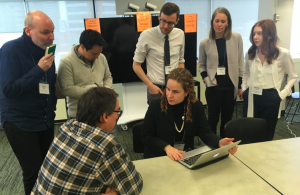
So in conclusion: let’s start doing a better job by leveraging the tools we already use. Let’s talk about getting ebooks certified accessible. Let’s talk about ebook distribution and how to use metadata to boost the discoverability of your digital publishing products. Let’s talk about folding the work of print-disabled experts into your workflow. It’s good for your profile, good for your bottom line, and good for business.
Our thanks to Laura and Daniella for enabling a wider, international audience to benefit from their wisdom.
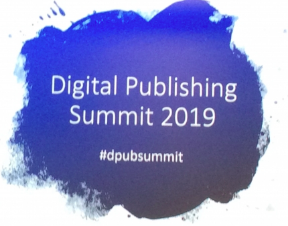 The 2019 edition of the Digital Publishing Summit took place in Paris (France) on June 25-26. This increasingly popular two-day conference—now in its fourth iteration—is organised by the not-for-profit organization EDRLab (European Digital Reading Lab). The conference began in 2016 in the town of Bordeaux (France), then moved to Brussels (Belgium), followed by Berlin (Germany).
The 2019 edition of the Digital Publishing Summit took place in Paris (France) on June 25-26. This increasingly popular two-day conference—now in its fourth iteration—is organised by the not-for-profit organization EDRLab (European Digital Reading Lab). The conference began in 2016 in the town of Bordeaux (France), then moved to Brussels (Belgium), followed by Berlin (Germany).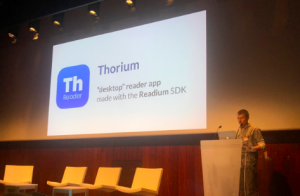
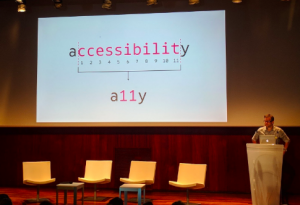
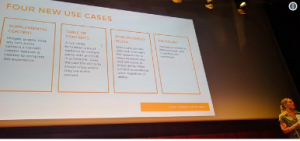 I anticipate that in some not-too-distant future, there will be similar validation/checking tools to help with the production of audio books. In her presentation, Wendy Reid (Kobo) walked us through the W3C audio books standardization effort, which includes a strong recognition of the need for a structured table of contents (not just a playlist of MP3 files!), accessible descriptions, as well as the potential of more advanced features like escapability and skippability (which are well-known concepts in DAISY Digital Talking Books)
I anticipate that in some not-too-distant future, there will be similar validation/checking tools to help with the production of audio books. In her presentation, Wendy Reid (Kobo) walked us through the W3C audio books standardization effort, which includes a strong recognition of the need for a structured table of contents (not just a playlist of MP3 files!), accessible descriptions, as well as the potential of more advanced features like escapability and skippability (which are well-known concepts in DAISY Digital Talking Books)


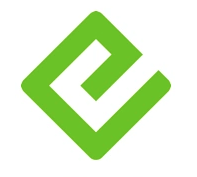 Accessible books were originally produced by organizations working for people with disabilities who are, of course, the accessibility experts. Publishers are now expected to produce accessible publications but they are not accessibility experts like the organizations working for people with disabilities.
Accessible books were originally produced by organizations working for people with disabilities who are, of course, the accessibility experts. Publishers are now expected to produce accessible publications but they are not accessibility experts like the organizations working for people with disabilities.

 This article was kindly submitted by Laura Brady and Daniella Levy-Pinto who are presenting this Business Case for Accessibility at The Toronto Book Summit 2019 on June 18. Laura is Director of Cross-Media at House of Anansi Press and runs the highly respected and popular ebookcraft conference in Canada. Daniella is the Coordinator for Accessibility Testing with the National Network for Equitable Library Service (NNELS). As a totally blind reader, Daniella has considerable experience with accessible formats and accessible reading.
This article was kindly submitted by Laura Brady and Daniella Levy-Pinto who are presenting this Business Case for Accessibility at The Toronto Book Summit 2019 on June 18. Laura is Director of Cross-Media at House of Anansi Press and runs the highly respected and popular ebookcraft conference in Canada. Daniella is the Coordinator for Accessibility Testing with the National Network for Equitable Library Service (NNELS). As a totally blind reader, Daniella has considerable experience with accessible formats and accessible reading. 




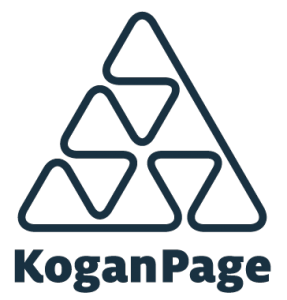 Accessibility: The quality or characteristic of something that makes it possible to approach, enter or use it
Accessibility: The quality or characteristic of something that makes it possible to approach, enter or use it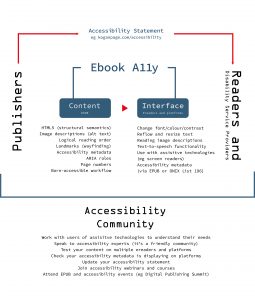
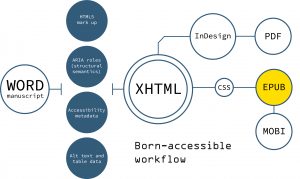
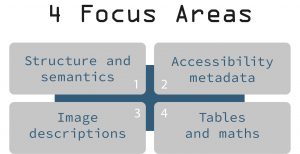


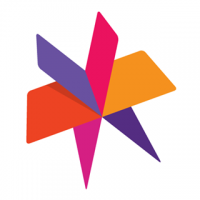 This year the 2 day Copyright Seminar held at the
This year the 2 day Copyright Seminar held at the 
 In March, textBOX examined the challenges in delivering accessible web content for print-disabled college students in
In March, textBOX examined the challenges in delivering accessible web content for print-disabled college students in 